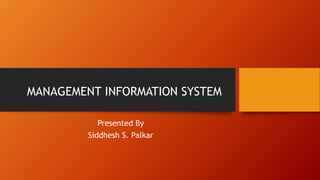
Management Information System ( MIS )
- 1. MANAGEMENT INFORMATION SYSTEM Presented By Siddhesh S. Palkar
- 2. INTRODUCTION • The MIS is an idea which is associated with man, machine, marketing and methods for collecting information’s from the internal and external source and processing this information for the purpose of facilitating the process of decision-making of the business. • MIS is basically concerned with processing data into information and is then communicated to the various department in an organization for appropriate decision making.
- 3. WHAT IS MIS ? • Right Information • To the right person • At the right place • At the right time • In the right form • At the right cost
- 4. COMPONENTS OF MIS • Management Management covers the planning, control, and administration of the operations of a concern. • Information Information, in MIS, means the processed data that helps the management in planning, controlling and operations. • System Data is processed into information with the help of a system. A system is made up of inputs, processing, output and feedback or control.
- 5. CHARACTERISTICS OF MIS • Provide reports with fixed and standard formats – Hard copy and soft copy reports • Uses internal data stored in computer system • End users can develop custom reports • Requires formal requests from users
- 7. TYPES OF MIS • Transaction Processing System (TPS) MIS produce fixed ,regularly scheduled reports based on data extracted and summarized from the firms underlying transaction processing systems to middle and operational level managers to identify and inform structured and semi structured decision problems • Decision support system (DSS) This are computer applications used by middle management to compile information from a wide range of sources to support problem solving and decision making .
- 8. TYPES OF MIS • Executive Support System (ESS) Executive Support System (ESS) is software used by companies which has information related to business, which enables the top management to take better decisions in favor of the company. • Customer Relationship Management (CRM) This are MIS designed specifically for managing the marketing aspects of the business .
- 9. ROLE OF MIS The role of the MIS in an organization can be compared to the role of heart in the body. The information is the blood and MIS is the heart. In the body the heart plays the role of supplying pure blood to all the elements of the body including the brain. The MIS plays exactly the same role in the organization. The system ensures that an appropriate data is collected from the various sources, processed and send further to all the needy destinations. The system is expected to fulfill the information needs of an individual, a group of individuals, the management functionaries: the managers and top management.
- 10. IMPORTANT ROLES OF MIS • The MIS helps the junior management personnel by providing the operational data for planning, scheduling and control , and helps them further in decision-making at the operation level to correct an out of control situation. • The MIS helps the middle management in short term planning, target setting and controlling the business functions. It is supported by the use of the management tools of planning and control.
- 11. IMPORTANT ROLES OF MIS • The MIS helps the top level management in goal setting, strategic planning and evolving the business plans and their implementation. • The MIS plays the role of information generation, communication, problem identification and helps in the process of decision- making.
- 12. ADVANTAGES • Companies are able to highlight their strengths and weaknesses due to presence of revenue reports, employees performance record etc. The identification of these aspects can help the company improve their business processes and operations . • Giving an overall picture of the company and acting as a communication and planning tool .
- 13. ADVANTAGES • The availability of the of the customer data and feedback can help the company to align their business processes according to the needs of the customers . The effective management of customer data can help the company to perform direct marketing and promotion activities . • Information is considered to be an important asset for any company in the modern competitive world .
- 14. OUTPUTS OF MIS Scheduled reports : Produced periodically or scheduled (daily , weekly or monthly) Key indicator reports : Summarized the previous day’s critical activities . Demand reports: Gives certain reports at managers request. Exception reports: Automatically produced when a situation is unusual or requires management action.
- 15. IMPACT OF MIS • With a good support of MIS, Marketing, Finance, Production & Personal Management becomes more efficient. • The impact is on the managerial ability to perform. It improves decision-making ability considerably high. • The employee also in turn discuss their doubts concerns and problems
- 16. IMPACT OF MIS • MIS plays a very important role in the organization; it creates an impact on the organization’s functions, performance and productivity. • The manager is kept alert by providing certain information indicating and probable trends in the various aspects of business. This helps in forecasting and long-term perspective planning. • MIS gives better understanding of business.
- 17. CONCLUSION The MIS gets data and other resources of IT infrastructure as inputs from the environment and process them to satisfy the information needs of different entities associated with the business enterprise. There are subsystems of control over the use of IT resources and feedback system offers useful clues for increasing the benefits of information system to business.
- 18. THANK YOU